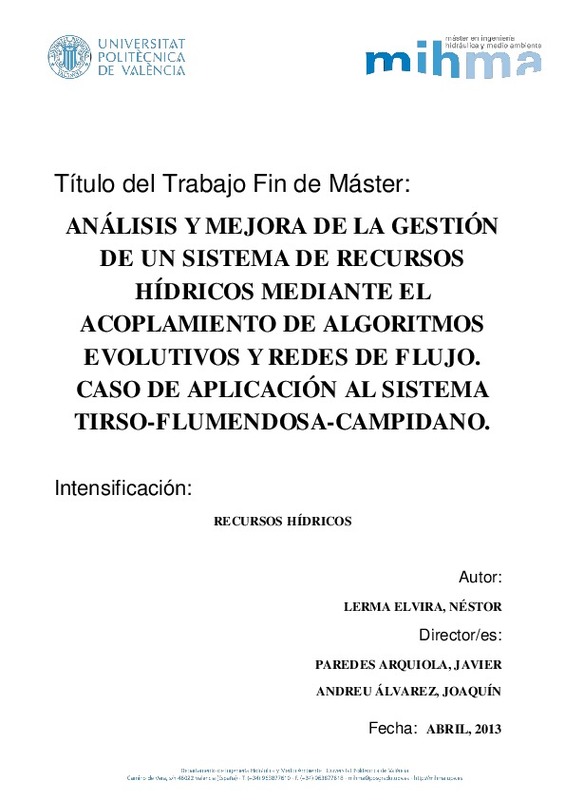|
Resumen:
|
[EN] Water is an essential resource for human life and, therefore, in recent years, water specialists are working on improving the use of this common good. Water planning is one of the key instruments for the integrated ...[+]
[EN] Water is an essential resource for human life and, therefore, in recent years, water specialists are working on improving the use of this common good. Water planning is one of the key instruments for the integrated management of water resources, where management rules are some of the strategies used to improve the utilization of these resources.
This study describes a methodology to optimize the water resources system management through management rules. The methodology proposed is, on one hand, to attach evolutionary optimization algorithms (SCE-UA and Scatter Search) and, on the other hand, a flow network model (SIMGES). This latter model allows to simulate the operation of a water system and water allocation among different users in the basin, while the optimization algorithms are used as tools to control the successive simulations and are changing the rules of management.
For this purpose, it has been developed a computer program in Visual Basic for Applications which code is incorporated into the optimization algorithm employed, the results of management SIMGES and simulated objective function which allows the algorithm to optimize the management.
The methodology has been applied to operating system Tirso-Flumendosa-Campidano located on the island of Sardinia (Italy). To carry out this task it has been created a model in the Decision Support System AQUATOOL, and a set of scenarios that allow understanding the system behavior and see what areas require a specific management. In these areas is where the methodology is applied to optimize
[-]
[ES] El agua es un recurso imprescindible para la vida humana y, por ello, en los últimos años, especialistas en recursos hídricos están trabajando en la mejora del aprovechamiento de este bien común. La planificación ...[+]
[ES] El agua es un recurso imprescindible para la vida humana y, por ello, en los últimos años, especialistas en recursos hídricos están trabajando en la mejora del aprovechamiento de este bien común. La planificación hidrológica es uno de los instrumentos fundamentales para la gestión integral del recurso hídrico, donde las reglas de gestión son algunas de las estrategias empleadas para mejorar el aprovechamiento de dichos recursos.
En este estudio se describe una metodología que permita optimizar la gestión de un sistema de recursos hídricos a través de reglas de gestión. La metodología planteada consiste en acoplar, por un lado, algoritmos de optimización evolutivos (SCE-UA y Scatter Search) y, por otro lado, un modelo de redes de flujo (SIMGES). Este último permite simular la gestión de un sistema de recursos hídricos y el reparto del agua entre los diferentes usuarios de la cuenca, mientras que los algoritmos de optimización se utilizan como herramientas que controlan las sucesivas simulaciones y que van modificando las reglas de gestión.
Con este fin, se ha desarrollado una aplicación informática en Visual Basic para Aplicaciones en la cual se incorpora el código del algoritmo de optimización a emplear, los resultados de la gestión simulada con SIMGES y la función objetivo que permite al algoritmo optimizar dicha gestión.
La metodología se ha aplicado al sistema de explotación Tirso-Flumendosa-Campidano ubicado en la isla de Cerdeña (Italia). Para poder llevar a término esta tarea se ha creado un modelo, en el Sistema Soporte a la Decisión AQUATOOL, y un conjunto de escenarios de cálculo que han permitido entender el funcionamiento del sistema y ver en qué zonas se requería de una gestión específica. En estas zonas es donde se aplica la metodología para optimizar la gestión del sistema.
[-]
|







